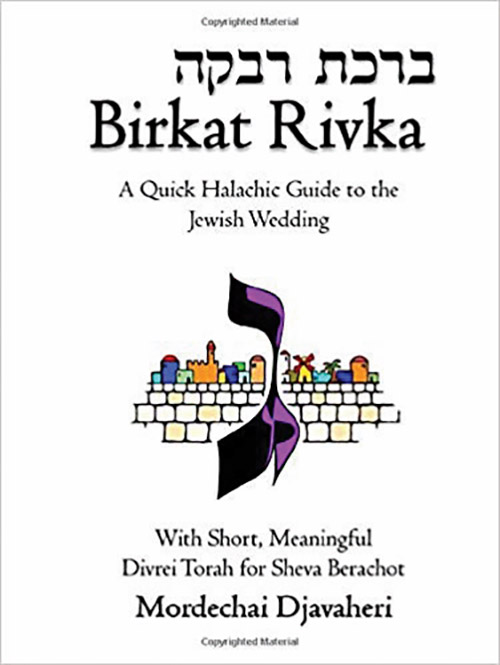
In today’s busy world we need to maximize the mileage from the shiurim to which we listen and the sefarim from which we learn. Rav Mordechai Djavaheri, a Sephardic superstar senior rabbinical student at Yeshiva University, has written a compact, concise, rich and riveting review of the central issues involved with the Jewish wedding. Chacham Mordechai delivers a high-mileage work that is definitely worth investing the time.
An added bonus is for today’s world where, baruch Hashem, weddings between Sephardic and Ashkenazic Jews are becoming more and more common, Rav Mordechai helps us navigate these differences in regards to the respective practices of both communities. Even better is that Rav Djavaheri presents brief wedding divrei Torah so that one will always have something perfect to say when asked to speak at a sheva brachot. The book is an outstanding and can’t-miss blend of Halacha and hashkafa.
Few books may be described as a must-read. “Birkat Rivka” is a small gem that belongs in the rarified air of the top, indispensable English-language Torah books. The following is a sample chapter summary that is relevant to this week’s parsha.
Avraham Siv: An Excerpt from Rav Mordechai Djavaheri’s “Birkat Rivka: Highlights of the Jewish Wedding and Sheva Berachot.” A Digest of Derashot and Halachot for Ashkenazim and Sepharadim
Since the times of the Geonim, Sepharadic communities have celebrated the Shabbat following the wedding, known as the Shabbat Chatan, with a special ritual involving the reading of “Ve’Avraham Zaken” (Bereishit 24:1-7), in which Avraham Avinu directs Eliezer to find an appropriate wife for Yitzchak Avinu from Avraham’s family and not from Kena’an. For this reason, the Shabbat Chatan is also known as “Shabbat Ve’Avraham Zaken.” Others refer to the reading as “Avraham Siv,” the Aramaic translation of “Ve’Avraham Zaken.”
An additional sefer Torah is taken out for Kriat HaTorah, the chatan carries it to the bimah, and he is given an aliyah. Generally, the chatan receives one of seven weekly aliyot first, and then he reads “Ve’Avraham Zaken” from the other sefer Torah before reciting the concluding bracha or, more commonly, from a printed Chumash, after the concluding bracha. Some have the custom for him to only get an aliyah from the additional sefer Torah and not read the weekly parsha at all. In all cases, the Aramaic translation is read by someone else in between pesukim. Some read each Hebrew pasuk twice, while others do not repeat. For most communities, this is the only remaining vestige of the custom of translating the Torah reading dating back to Talmudic times. Ultimately, all variations of the custom have what to rely upon, and one should uphold his tradition, not modify it. This custom is completely non-existent in Ashkenazi communities, and it is not ubiquitous to Sepharadi communities either.
The choice to read these pesukim on the Shabbat Chatan may stem from its positive reflection on marriage, which contributes to simchat chatan v’kallah and compensates when that week’s parsha does not contain such uplifting motifs. Moreover, the value of finding a suitable partner with whom to serve Hashem is highlighted, to discourage people from getting married for the wrong reasons (wealth and honor), as such a marriage will not last. A woman of good and preferably similar stock will produce children who are loyal and dedicated to the service of Hashem.
In Tunis, the chatan would conclude by picking up the sefer Torah, making a public donation, and circling around the bimah. The whole experience would make a profound impact on the chatan and his family, as if he took a public oath to raise his children in accordance with our Torah heritage.
Finally, a few pesukim from the haftarah of “Sos Asis” (Yeshayahu 61:10-63:9, read for Parshat Nitzavim), which contains chatan and kallah imagery, would be appended to the regular haftarah reading, but today this custom is no longer observed by any Jewish community.
Rabbi Haim Jachter is the spiritual leader of Congregation Shaarei Orah, the Sephardic Congregation of Teaneck. He also serves as a rebbe at Torah Academy of Bergen County and a dayan on the Beth Din of Elizabeth.













